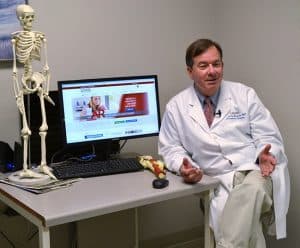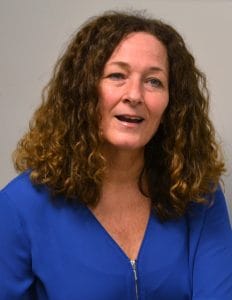New Hip Gives Dardanelle Woman Back Her Life
| Oct. 1, 2015 | By the time Nancy Zerr turned to Lowry Barnes, M.D., and UAMS for a total hip replacement, she was ready for the pain to stop.
“For about a year and half before the surgery, it was hard to sleep at night. It was hard to get out of bed and walk,” Zerr said, describing the bone-on-bone pain from osteoporosis in her hip as feeling “like a terrible tooth ache that just wouldn’t go away.”
Barnes, chairman of the Department of Orthopaedic Surgery in the College of Medicine, came highly recommended – both from a friend of Zerr’s who had undergone total hip replacement surgery with Barnes and from a stranger on the street.
“I was in my hometown and a woman I didn’t know came up to me. She saw me having trouble walking and said, ‘You need hip replacement surgery, don’t you’? I said yes, and she said, ‘Go to UAMS. Dr. Barnes, he’s the best.’”
Zerr, of Dardanelle, said she was amazed at how easy the surgery was. She arrived at the hospital that morning for surgery and was back in her room by noon. She was using a walker to get around her hospital room that afternoon. The next day, she met with a physical therapist and then was discharged.
“While I was at UAMS, I was shown how to do my exercises and told to do them three times a day. Because of that, I didn’t need outpatient physical therapy visits or anyone to come to my house,” she said, adding that was a big help since she wasn’t supposed to drive for several weeks after the surgery.
Four weeks after her surgery, Zerr was back at work at Arkansas Nuclear One in Russellville.
Total hip replacements weren’t always this way, said Barnes.
“When I finished my residency in 1991, the average length of stay for a joint replacement was 12 days, he said. “Now patients come to the hospital the morning of their surgery and usually go home the next day. It is a marked difference.”
Barnes noted that there have been many improvements to the process, including the way that pain is managed.
“Now we use special injections into the wound at the time of surgery and that really helps control pain. Patients don’t hurt so much after surgery, allowing them to get up and get moving,” he said.
With minimal surgical discomfort, patients can experience quick relief from the pain that drove them to undergo the procedure in the first place.

Lowry Barnes, M.D., said joint replacement surgeries have changed drastically in the approximately 25 years he has been an orthopedic surgeon.
“We tell patients in our office that we expect them to start feeling better immediately, Barnes said. “Patients should feel better the day after surgery than they did the day before.”
Barnes said that for many of his patients, the procedure is life changing.
“I had one patient about 15 years ago who had been living in a nursing home for more than 20 years because both of her hips were worn out. We replaced her hips and she moved to independent living,” he said with a smile.
“Those outcomes are absolutely why I do what I do,” he said. “Joint replacement, a subspecialty of orthopedics, is all about restoring function and mobility. It’s a very rewarding specialty.”
Zerr said she’s the one reaping the rewards. Eight weeks after the surgery, she feels wonderful.
“Everyone says you get your life back, but that’s truly how I feel. I got my life back,” she said. “You don’t realize the stress that the constant pain puts on you. You just don’t have any energy. Now, I feel like I did years ago.”

